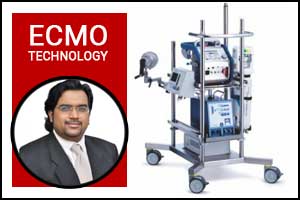- Home
- Editorial
- News
- Practice Guidelines
- Anesthesiology Guidelines
- Cancer Guidelines
- Cardiac Sciences Guidelines
- Critical Care Guidelines
- Dentistry Guidelines
- Dermatology Guidelines
- Diabetes and Endo Guidelines
- Diagnostics Guidelines
- ENT Guidelines
- Featured Practice Guidelines
- Gastroenterology Guidelines
- Geriatrics Guidelines
- Medicine Guidelines
- Nephrology Guidelines
- Neurosciences Guidelines
- Obs and Gynae Guidelines
- Ophthalmology Guidelines
- Orthopaedics Guidelines
- Paediatrics Guidelines
- Psychiatry Guidelines
- Pulmonology Guidelines
- Radiology Guidelines
- Surgery Guidelines
- Urology Guidelines
Why ECMO technology is a must have for every Emergency Care Center- Dr. Sanjith Saseedharan

The Russian novelist Leo Tolstoy once said: “The two most powerful warriors are time and patience”.These are the two most important attributes needed to treat an illness, a sickness or organ failure. We need to be ‘patient‘for the treatment to act, as there are no quick fixes to major life-threatening illnesses and the human body needs some“time” for the organs to get stronger and the drugs to act. Many a time, when a patient is waiting for a new organ via cadaveric organ donation, he/she needs time and his/her existing organ may not be able to pull through till he/she gets one. This is exactly what Extracorporeal Membrane Oxygenation (ECMO)is. It is an aggressive form of life support system, used when a person is critically ill, which buys some time till the primary disease or condition can be tackled.
For this process, large pipes also called as Cannulae are inserted in the groin or neck to access the blood vessels. Through these Cannulae, blood is pumped out into a machine which removes carbon dioxide and Oxygen is pumped into the blood(the very function that our Cardiopulmonary System ensures). This can also be referred to as a Heart-Lung Bypass. This form of support is a very highly specialized form of treatment which requires close coordination between Doctors, Perfusionists, laboratory personnel, respiratory therapists and Nurses. A patient can be maintained on Extracorporeal Membrane Oxygenation for an extended period of time, maybe days to weeks, while the underlying problem of the patient is treated. There are two kinds of ECMO-Venoarterial (VA) ECMO and Veno-venous (VV) ECMO. Venoarterial (VA) ECMO supports both the Lungs and the Heart. To conduct VA ECMO, one Cannula is placed in a major Artery and the other is placed in a major Vein. Veno-venous (VV) ECMO is used for Lung support only. For VV ECMO, one to two Cannulas is placed in major Veins. Patients are given strong blood thinners during ECMO, to prevent the blood from clotting.
Patients who require ECMO are those that have severe reversible Cardiac or Respiratory Failure. This kind of support becomes a life-saving boon to patients that present to the emergency room with massive Cardiac, Lung or large vessel trauma, smoke inhalation, severe Pneumonia, drowning and Status Asthmaticus that is unresponsive to the maximal line of management. One area where the ECMO has contributed extensively is cases pre and post Cardiac Transplant, and as a bridge to the transplant. During the course of ECMO treatment, the Heart of the patient continues to beat and its functioning is made easier as the ECMO machine does most of the pumping.
This therapy is well established in neonates when they suffer from Cardio-Respiratory Failure owing to birth defects, Meconium Aspiration, Congenital Diaphragmatic Hernia, trauma or severe infection. Adult ECMO has been around for the last 30 odd years, however, the last two decades or so have improved our understanding of the device and the procedure, making it a safe and effective treatment. This essential piece of equipment is resorted to when everything else is failing, making this technology a “must have” for centres dealing with emergencies.
ECMO support is still very expensive in India and probably not within the reach of all categories of patients. Presence of this device in Emergency Care Centers will definitely give hope to those patients who are staring at death for a simple want of time.
The author, Dr. Sanjith Saseedharan is the Head, Intensive Care Unit, SL Raheja Hospital, Mahim- A Fortis Associate.

Disclaimer: This site is primarily intended for healthcare professionals. Any content/information on this website does not replace the advice of medical and/or health professionals and should not be construed as medical/diagnostic advice/endorsement or prescription. Use of this site is subject to our terms of use, privacy policy, advertisement policy. © 2020 Minerva Medical Treatment Pvt Ltd